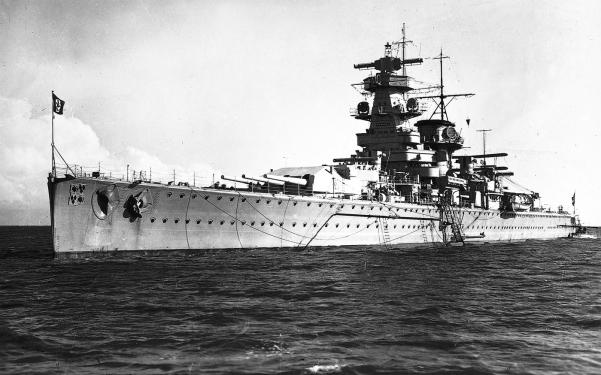
Officially classed as a Panzerschiff (Armoured Ship), but more popularly known as a “pocket battleship”, the Admiral Graf Spee and her two sisters, the Admiral Scheer and Deutschland, were designed as commerce raiders with a large radius of action and complied with the restrictions imposed on Germany by the terms of the Treaty of Versailles (which was detested by the Nazi Party). The “pocket battleship” nickname derived from the fact that, although they were too small to be classed as battleships, they were more powerful and faster than most other warships then afloat. Their hulls were electrically welded, and armour protection was sacrificed to produce a higher speed.
The Graf Spee was launched in June 1934 and completed in January 1936. In 1936–37, during the Spanish Civil War, she was engaged in blockading Republican ports. Between September and November 1939, during a sortie into the South Atlantic, she sank or captured nine British merchant vessels before being brought to battle by a British naval force comprising the cruisers Exeter, Ajax and Achilles off the estuary of the River Plate. Forced to seek refuge in the neutral port of Montevideo, on 17 December she was scuttled; her captain, Hans Langsdorff, committed suicide rather than be taken prisoner.
Specifications
- Type
- Pocket Battleship
- Length
- 187.9m (616.5ft)
- Beam
- 21.64m (71ft)
- Draught
- 7.31m (24ft)
- Displacement (normal)
- 13,818tnes (13,600t)
- Displacement (full load)
- 16,279tnes (16,023t)
- Machinery
- Diesel
- Armour (belt)
- 58.42mm (2.3in)
- Armour (deck)
- 40.64mm (1.6in)
- Armour (turrets)
- 139.7mm (5.5in)
- Guns
- 6x11in; 8x5.9in; 6x3.5in
- AA guns
- None
- Aircraft
- Two
- Crew
- 1150
- Launched
- June 1934
- Speed
- 26 knots
